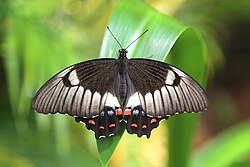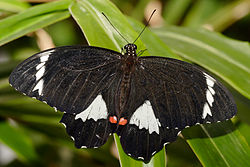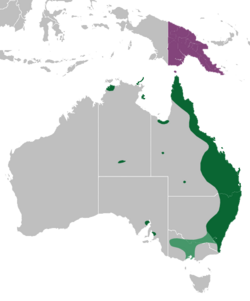| Orchard swallowtail butterfly | |
|---|---|
 | |
| Female, Cairns, Queensland | |
 | |
| Male, Melbourne Zoo | |
| Scientific classification | |
| Domain: | Eukaryota |
| Kingdom: | Animalia |
| Phylum: | Arthropoda |
| Class: | Insecta |
| Order: | Lepidoptera |
| Family: | Papilionidae |
| Genus: | Papilio |
| Species: | P. aegeus |
| Binomial name | |
| Papilio aegeus Donovan, 1805 | |
| Subspecies | |
| |
 | |
| Range of orchard swallowtail P. a. aegeus; P. a. ormenus P. a. aegeus temporary range | |
| Synonyms | |
| |
Papilio aegeus, the orchard swallowtail butterfly or large citrus butterfly is a species of butterfly from the family Papilionidae, that is found in eastern Australia and Papua New Guinea.
Contents
- Description
- Description in Seitz
- Distribution
- Variation
- Subspecies
- Forms
- Life cycle
- Egg
- Larva
- Pupa
- Images of life cycle
- Larval food plants
- Native
- Introduced
- Taxonomy
- References
- Cited texts
- External links
The larvae of this species are sometimes considered a pest, due to their feeding on citrus leaves in suburban gardens. [1]








